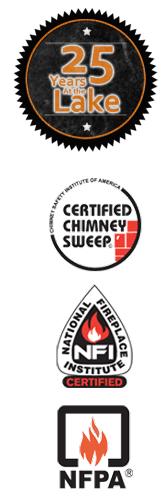Safety Tips
Safety Tips
Wood Selection
To reduce creosote build-up in your chimney, burn seasoned hardwood such as oak, or hickory. It is best to split, stack and then allow your wood to dry for at least one year before burning. When burning your wood, moisture should never bubble out of the end grain. This would indicate wet or poorly seasoned wood. We recommend 12 to 20 percent moisture for seasoned firewood.
Burning painted, or treated wood can give off toxic fumes. Avoid plywood, particle board for the same reason. A small amount of paper, placed under the grate is fine to start a fire, but large amounts of paper and gift wrapping should not be burned because it creates a large flame that can reach creosote deposits and start a chimney fire.
Carbon Monoxide
Thousands of Homeowners are hospitalized and each year many die from exposure and poisoning of carbon monoxide. This colorless, odorless, but deadly gas can infiltrate your home in various ways, but home heating is a primary category of CO poisoning.
Whether serving a wood burning fireplace or stove, or your gas furnace, chimneys must be free of restriction and blockages.
Knowing a chimney lining is without voids and can properly vent the products of combustion goes a long way in safety and peace of mind . A professional chimney inspection/sweep, and a proper chimney cover with an animal guard can help insure this.
Remember to never heat your home with a charcoal grill – even in emergencies or power loss.
All heating appliances, regardless of fuel, should be checked for improper function and deteriorated heat exchangers etc.
We recommend every home have a carbon monoxide detector and a smoke alarm.
Creosote Removal
Fireplaces and wood stoves are designed to safely contain wood-fuel fires, while providing heat for a home. Chimneys, however, are not intended to contain the fire at all.
As the smoke is expelled through the chimney flue, the substances contained in the smoke will stick to the surfaces of the flue lining. The resulting residue is called creosote. Creosote is black or brown in color. The lighter forms of creosote is sometimes referred to as soot while the harder flaky and shiny deposits are various forms of creosote. All forms of soot and creosote are flammable, and in sufficient quantities may catch fire inside the the chimney flue causing a chimney fire. While many chimney fires stay contained inside the flue, it is not uncommon for a chimney fire to become a structural fire as well.
Chimney Sweeping is the primary defense against chimney fires.
If you burn wood for heat or have frequent fires during the burning season, your chimney should be swept yearly.
The National Fire Protection Association Recommends chimney inspections once a year and maintenance and repairs done if necessary.
The Chimney Safety Institute of America recommends sweeping if 1/8” or more of soot or creosote is present anywhere in the chimney system.
There are many variables to consider regarding frequency of service.
When in doubt, call for a professional inspection!
Our CSIA Certified Chimney Sweep may make additional recommendations or suggestions at the time of service.
